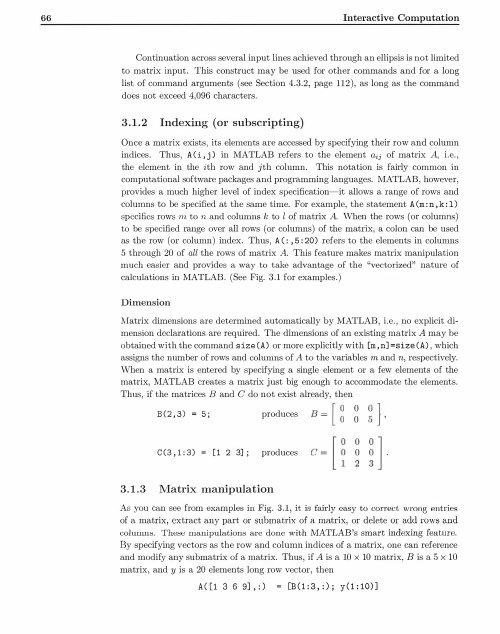You also want an ePaper? Increase the reach of your titles
YUMPU automatically turns print PDFs into web optimized ePapers that Google loves.
66 Interactive Computation<br />
Continuation across several input lines achieved through an ellipsis is not limited<br />
to matrix input. This construct may be used for other commands and for a long<br />
list of command arguments (see Section 4.3.2, page 112), as long as the command<br />
does not exceed 4,096 characters.<br />
3.1.2 Indexing (or subscripting)<br />
Once a matrix exists, its elements are accessed <strong>by</strong> specifying their row and column<br />
indices. Thus, A ( i , j) in <strong>MATLAB</strong> refers to the element aij of matrix A, i.e.,<br />
the clement in the ith row and jth column. This notation is fairly common in<br />
computational software packages and programming languages. <strong>MATLAB</strong>, however,<br />
provides a much higher level of index specification-it allows a range of rows and<br />
columns to be specified at the same time. For example, the statement A(m:n,k:l)<br />
specifies rows rn to n and columns k to l of matrix A. When the rows (or columns)<br />
to be specified range over all rows (or columns) of the matrix, a colon can be used<br />
as the row (or column) index. Thus, A(: ,5:20) refers to the elements in columns<br />
5 through 20 of all the rows of matrix A. This feature makes matrix manipulation<br />
much easier and provides a way to take advantage of the "vectorized" nature of<br />
calculations in <strong>MATLAB</strong>. (See Fig. 3.1 for examples.)<br />
Dimension<br />
Matrix dimensions are determined automatically <strong>by</strong> <strong>MATLAB</strong>, i.e., no explicit dimension<br />
declarations are required. The dimensions of an existing matrix A may be<br />
obtained with the command size (A) or more explicitly with [m , n] =size (A) , which<br />
assigns the number of rows and columns of A to the variables m and n, respectively.<br />
When a matrix is entered <strong>by</strong> specifying a single element or a few elements of the<br />
matrix, <strong>MATLAB</strong> creates a matrix just big enough to accommodate the elements.<br />
Thus, if the matrices B and C do not exist already, then<br />
B(2,3) = 5;<br />
produces<br />
0<br />
0<br />
C(3,1:3) [1 2 3] ; produces<br />
0<br />
0<br />
2<br />
3.1.3 Matrix manipulation<br />
As you can see from examples in Fig. 3.1, it is fairly easy to correct wrong Pntries<br />
of a matrix, extract any part or submatrix of a matrix, or delete or add rows and<br />
columns. These manipulations are done with <strong>MATLAB</strong>'s smart indexing feature.<br />
By specifying vectors as the row and column indices of a matrix, one can reference<br />
and modify any submatrix of a matrix. Thus, if A is a 10 x 10 matrix, B is a 5 X 10<br />
matrix, and y is a 20 elements long row vector, then<br />
A([1 3 6 9] ,:) = [B ( 1:3,:); y(1: 10)]



